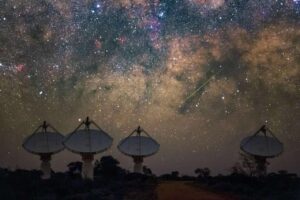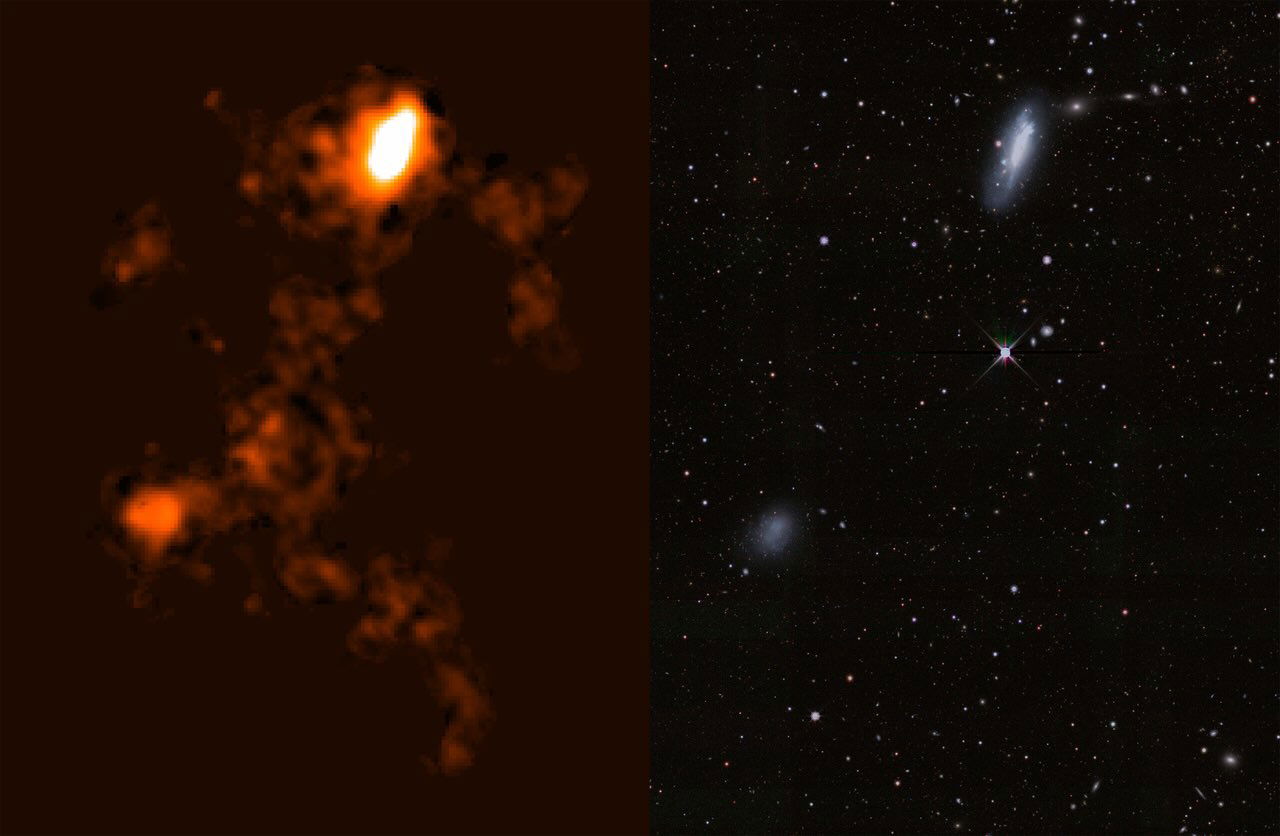Spanning the gulf between two dwarf galaxies, an immense strand of hydrogen gas is acting as a cosmic bridge 53 million light-years from Earth, according to Australian astronomers.
The discovery was made at the International Centre for Radio Astronomy Research’s (ICRAR) node at the University of Western Australia (UWA). Stretched between the NGC 4532 and DDO 137 galaxies, the hydrogen bridge measures 185,000 light-years in length, as revealed in a new paper published in the Monthly Notices of the Royal Astronomical Society.
Mapping the Cosmos
Named for one of Australia’s most famous indigenous species, the work fell under the Widefield ASKAP L-band Legacy All-sky Survey, or “WALLABY.” The WALLABY project focuses on mapping the sky to better understand how hydrogen gas is distributed between galaxies at large scales, as well as the impact of stellar and black hole feedback.
Data for the project comes from the Australian Square Kilometre Array Pathfinder, also known as the ASKAP radio telescope, located at the CSIRO Murchison Radio-astronomy Observatory. The radio telescope is located in a radio-quiet zone, where transmissions in the area are heavily restricted to ensure high-quality observations that are free of local interference. CSIRO is Australia’s national science agency, responsible for funding and overseeing a variety of research projects in various disciplines.
 Home of the WALLABY project, CSIRO’s ASKAP radio telescope on Wajarri Yamaji Country. Credit: Alex Cherney/CSIRO
Home of the WALLABY project, CSIRO’s ASKAP radio telescope on Wajarri Yamaji Country. Credit: Alex Cherney/CSIRO
Discovering a Galactic Bridge
Through the WALLABY work, the ICRAR UWA researchers were able to examine high-resolution observations of neutral hydrogen. Interested in the gas’s impact on the galaxy around it, the team identified immense gas formations far out in space.
“Neutral hydrogen plays a crucial role in the formation of stars, making this finding fundamental to understanding how galaxies interact and evolve, particularly in dense environments,” said co-author Professor Kenji Bekki of ICRAR UWA.
Modeling revealed that the tidal forces between NGC 4532 and DDO 137, combined with their movement toward the Virgo cluster of galaxies, were responsible for the unusual gas dynamics.
“As the galaxies rotated around each other and moved toward the hot gas cloud surrounding the Virgo cluster, which was 200 times hotter than the Sun’s surface, they experienced what is known as ram pressure, which stripped and heated the gas from the galaxies,” explained lead author Professor Lister Staveley-Smith of ICRAR UWA. “The process is akin to atmospheric burn-up when a satellite re-enters the Earth’s upper atmosphere, but has extended over a period of a billion years.”
Two major factors—the density of electrons in the region and the speed at which galaxies fall into the hot gas cloud—drive the stripping process, pulling vast amounts of gas away to form the hydrogen bridge.
Dwarf Galaxies and the Local Group
“This contributes to our broader understanding of the most massive structures in the Universe and their life cycles, which helps us grasp more about their vast complexities and history of star formation,” Professor Staveley-Smith said.
The finding also offers insights closer to home. The connection between NGC 4532 and DDO 137 resembles that of the Magellanic System, two irregular dwarf galaxies orbiting the Milky Way as part of the Local Group.
“Understanding these gas bridges and their dynamics provides critical insights into how galaxies evolve, how galactic gas is redistributed, and the varying conditions under which galaxies may or may not form stars,” Professor Staveley-Smith said.
Ongoing research across such vast distances will continue to refine scientists’ understanding of galactic evolution and shed light on the processes shaping our own cosmic neighborhood.
The paper, “WALLABY Pilot Survey: The Extensive Interaction of NGC 4532 and DDO 137 with the Virgo Cluster,” appeared in Monthly Notices of the Royal Astronomical Society on September 23, 2025.
Ryan Whalen covers science and technology for The Debrief. He holds an MA in History and a Master of Library and Information Science with a certificate in Data Science. He can be contacted at ryan@thedebrief.org, and follow him on Twitter @mdntwvlf.


